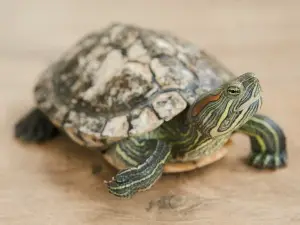
Turtles, just like any other animal, like to eat but they don’t only eat food, these animals can also be found munching on a variety of other things, like sand.
This behavior is quite peculiar and may have you wondering why the animals do this, this article looks into it
Table of Contents
Why is my turtle eating sand?
If your turtle is eating sand you may just wonder why on earth is this happening, and this is quite a valid concern.
Here is why your pet turtle may be doing this:
Calcium deficiency:
Another reason why your pet turtle may be eating sand may be that the animal has a calcium deficiency and is looking for this nutrient in the sand that it eats
What to do:
You’d need to take a closer look at what your pet turtle is eating and then offer them more calcium in their diet.
You can do this by leaving a slow-release calcium block in your pet’s water.
You can also give the turtle a cuttle bone, these are usually given to birds but can be given to turtles too. Giving them fresh prawns as a treat will help and giving them blood worms should also help.
It’s food related:
If you’ve just added the sand to your pet’s tank then the turtle at the moment may simply be curious about the sand and wonder if it is a tasty treat and may eat some to figure that out.
Another reason why your pet may be eating sand may be that the animal is simply looking and foraging for food and is accidentally eating some sand while foraging.
What to do:
This phenomenon isn’t something to worry about, it happens often to turtles.
These animals, when eating food from the ground, filter the sand while eating foraged food so you don’t have to worry about the animal eating too much sand and causing adverse effects.
The sand that the animal does ingest will pass through the animal’s digestive system just as any other inedible item would.
You only have to worry if the animal is over 4 inches long.
If you have a small baby turtle under 4 inches long, and it eats the sand that you used as a substrate then you may need to change the substrate.
These little animals can develop impaction after eating sand and die because of this.
You can use a substrate like orchard bark or eco earth in your little pet’s enclosure. If you choose to use aspen bedding, which is quite a dry substrate then you’d need to provide humidity in other ways.
You don’t have to worry about the sand causing impaction in your older turtle’s stomach, the risk of impaction is extremely low in this case.
What you should worry about is if the animal is eating large amounts of gravel, this can cause impaction as the gravel will clog the animal’s digestive system and kill the turtle.
If you don’t like that your turtle eating the sand in its enclosure then you can distract your pet with a tasty treat
Also, make sure that your pet is well hydrated so that the sand passes easily if ingested by the turtle
If you enjoyed this article then you may also be interested in other turtle/tortoise related articles. Here are some articles that you may be interested in: Why Is My Turtle Yawning Underwater?, Why Are My Turtles Eyes Closed, Why Is My Turtle Red?, Why Is My Turtle Pink?, Why Is My Turtle Twitching, Why Is My Turtle Restless?, Why Is My Turtle Yawning?, Why Is My Turtle Tank Foaming?, Why Is My Turtle Whistling

